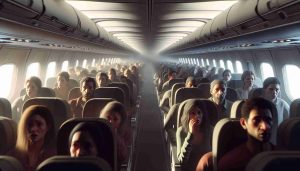A routine flight quickly turned chaotic on Monday when a Hawaiian Airlines flight headed to Hawaii was forced to return due to alarming fumes in the cabin. Shortly after takeoff from Seattle-Tacoma International Airport, the crew detected a significant issue that required immediate action.
As the aircraft made its way back, the captain declared an emergency, ensuring they received priority landing assistance. Remarkably, the Airbus A330 landed safely, and the aircraft was greeted on the tarmac by medical and fire personnel, ready to handle any potential emergencies. Fortunately, all 273 passengers along with 10 crew members were able to exit without incident.
Upon inspection by the Port of Seattle Fire Department, it was confirmed that there were no signs of smoke or odor inside the cabin, easing concerns among passengers. The flight was promptly cleared, allowing for a thorough investigation of the situation.
Less than a day later, Flight 21 took off again from Seattle, this time aboard a different aircraft, heading toward its original destination of Daniel K. Inouye International Airport in Honolulu.
The Federal Aviation Administration (FAA) has been contacted for additional details regarding this incident. Passengers can take comfort in the swift response of the crew and ground personnel, ensuring safety above all.
Flight Fiasco: Hawaiian Airlines Incident Highlights Aviation Safety Protocols and Response
### Hawaiian Airlines Flight Crisis: What Happened?
On a typical flight day, passengers aboard Hawaiian Airlines Flight 21 from Seattle to Hawaii faced unforeseen turbulence when the aircraft was forced to return shortly after takeoff due to smoke-like fumes in the cabin. This incident raises important questions about safety protocols and swift reaction by flight crews in the aviation industry.
### Emergency Response and Safety Measures
The crew’s quick recognition of the problem led to an emergency declaration, allowing the aircraft to receive priority landing assistance. The Airbus A330 successfully landed at Seattle-Tacoma International Airport, where emergency personnel were on standby. Fortunately, all 283 individuals onboard—273 passengers and 10 crew members—were safely evacuated without any reported incidents. This response underscores the training that flight crews undergo for emergency situations, emphasizing the critical importance of preparation and immediate action.
### Investigation Outcome and Health Considerations
After a thorough inspection by the Port of Seattle Fire Department, it was determined that there were no indications of smoke or dangerous odors within the aircraft, which alleviates health and safety concerns for those aboard. The incident serves as a reminder of the rigorous safety standards and protocols enforced in the aviation industry, with the FAA monitoring such occurrences closely to ensure continued passenger safety.
### Flight Resumption: Quick Recovery for Passengers
In a commendable turnaround, Hawaiian Airlines managed to rebook Flight 21 less than a day later, with passengers continuing their journey to Daniel K. Inouye International Airport in Honolulu aboard a different aircraft. This swift recovery highlights the airline’s commitment to customer service and operational resilience in face of unforeseen challenges.
### Insights into Aviation Safety Trends
The incident reflects a significant trend in aviation toward adopting advanced safety protocols and technology. Modern aircraft are equipped with a wide array of monitoring systems designed to instantly detect anomalies in cabin conditions, allowing for immediate corrective action. Furthermore, training programs for flight attendants and pilots emphasize emergency preparedness, ensuring they can manage crises effectively.
### Market Analysis: The Impact on Hawaiian Airlines
While incidents like this can impact the reputation of airlines, the proactive measures taken by Hawaiian Airlines may help mitigate negative perceptions. The airline industry has learned that transparency and prompt communication during emergencies are crucial for maintaining passenger trust. As travelers prioritize safety, airlines that demonstrate responsive action are more likely to foster loyalty among customers.
### Conclusion
The recent event involving Hawaiian Airlines demonstrates the paramount importance of aviation safety protocols and the effectiveness of emergency preparedness. As the industry continues to evolve, ensuring passenger safety, swift response capabilities, and effective communication will remain vital components in gaining and retaining public trust.
For more information about airline safety protocols and updates on aviation incidents, visit Hawaiian Airlines.







More Stories
A Thrilling Showdown Awaits! Volynets vs. Parks in Auckland Quarterfinals!
Remarkable Journey of a Rising Star! Discover the Story Behind Oregon’s Tez Johnson!
Will Biden’s Legacy Echo Carter’s? A Comparison of Two One-Term Presidents